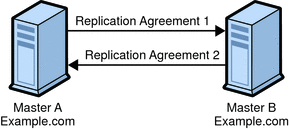Concepts of Multi-Master Replication
In a multi-master configuration, data is updated on multiple masters. Each master maintains a change log, and the changes made on each master are replicated to the other servers. Each master plays the role of supplier and consumer.
Multi-master configurations have the following advantages:
-
Automatic write failover occurs when one master is inaccessible.
-
Updates can be made on a local master in a geographically distributed environment.
Multi-master replication uses a loose consistency replication model. This means that the same entries may be modified simultaneously on different servers. When updates are sent between the two servers, any conflicting changes must be resolved. Various attributes of a WAN, such as latency, can increase the chance of replication conflicts. Conflict resolution generally occurs automatically. A number of conflict rules determine which change takes precedence. In some cases conflicts must be resolved manually. For more information, see Solving Common Replication Conflicts in Sun Directory Server Enterprise Edition 7.0 Administration Guide.
The number of masters that are supported in a multi-master topology is theoretically unlimited. The number of consumers and hubs is also theoretically unlimited. However, the number of consumers to which a single supplier can replicate depends on the capacity of the supplier server. You can use the SLAMD Distributed Load Generation Engine (SLAMD) to assess the capacity of the supplier server. For information about SLAMD, and to download the SLAMD software, see http://www.slamd.com.
Each supplier in a multi-master environment must have a replication agreement. The following figure shows two master servers and their replication agreements.
Figure 11–1 Multi-Master Replication Configuration (Two Masters)

In the preceding figure, Master A and Master B have a master replica of the same data. Each master has a replication agreement that specifies the replication flow. Master A acts as a master in the scope of Replication Agreement 1, and as a consumer in the scope of Replication Agreement 2.
Multi-master replication can be used for the following tasks:
-
To replicate updates by using the replica ID.
Updates by using the replica ID make it possible for a consumer to be updated by multiple suppliers at the same time, provided that the updates originate from different replica IDs.
-
To enable or disable a replication agreement.
Replication agreements can be configured but left disabled, then enabled rapidly when required. This feature provides flexibility in replication configuration. This can be done whether you use multiple masters or not.
- © 2010, Oracle Corporation and/or its affiliates
